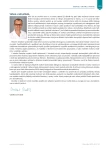Apolipoprotein L1 – ethnically specific determinant of renal and heart failure
Authors:
Jaroslav A. Hubáček
Authors‘ workplace:
Centrum experimentální medicíny IKEM, Praha
Published in:
AtheroRev 2019; 4(3): 159-161
Category:
Overview
Cardiovascular and renal diseases are responsible for worldwide high mortality and morbidity. Both diseases have a significant genetic background, and a number of genes (eg. apolipoprotein E and FTO genes) are involved in the development of both diseases. Another gene, whose variants are associated with the development of these diseases is the apolipoprotein L1 (APOL1) gene. There are several hundred polymorphisms within the APOL1. However, the results reported so far show that the risk variants of this gene (mostly referred to as G1 and G2; encoded by rs73885319/rs60910145 and rs71785313 SNPs) are strictly ethnically specific – they occur exclusively in Africans, but not in Europeans or Asians. Risky alleles increase the risk of renal failure 7–10 times and doubled the risk of cardiovascular disease development. Ethnic differences are the result of diverse evolution and different selection pressures (the evolutionary advantage of these alleles is the resistance to sleeping sickness) affecting different ethnic groups and underline the need for targeted personalized analyses, taking into account these differences.
Keywords:
Genetics – apolipoprotein L1 – ethnicity – renal failure
Sources
- Hubacek JA, Bloudickova S, Kubinova R et al. Apolipoprotein E polymorphism in hemodialyzed patients and healthy controls. Biochem Genet 2009; 47(9–10): 688–693. Dostupné z DOI: <http://dx.doi.org/10.1007/s10528–009–9266-y>.
- Holmes MV, Frikke-Schmidt R, Melis D et al. A systematic review and meta-analysis of 130,000 individuals shows smoking does not modify the association of APOE genotype on risk of coronary heart disease. Atherosclerosis 2014; 237(1): 5–12. Dostupné z DOI: <http://dx.doi.org/10.1016/j.atherosclerosis.2014.07.038>.
- Liu C, Mou S, Pan C. The FTO gene rs9939609 polymorphism predicts risk of cardiovascular disease: a systematic review and meta-analysis. PLoS One 2013; 8(8): e71901. Dostupné z DOI: <http://dx.doi.org/10.1371/journal.pone.0071901>.
- Hubacek JA, Viklicky O, Dlouha D et al. The FTO gene polymorphism is associated with end-stage renal disease: two large independent case-control studies in a general population. Nephrol Dial Transplant 2012; 27(3): 1030–1035. Dostupné z DOI: <http://dx.doi.org/10.1093/ndt/gfr418>.
- Estrella MM, Parekh RS. The expanding role of APOL1 risk in chronic kidney disease and cardiovascular isease. Semin Nephrol 2017; 37(6): 520–529. Dostupné z DOI: <http://dx.doi.org/10.1016/j.semnephrol.2017.07.005>.
- Peng T, Wang L, Li G. The analysis of APOL1 genetic variation and haplotype diversity provided by 1000 Genomes project. BMC Nephrol 2017; 18(1): 267. Dostupné z DOI: <http://dx.doi.org/10.1186/s12882–017–0675–6>.
- Duchateau PN, Pullinger CR, Cho MH et al. Apolipoprotein L gene family: tissue-specific expression, splicing, promoter regions; discovery of a new gene. J Lipid Res 2001; 42(4): 620–630.
- Bart JM, Cordon-Obras C, Vidal I et al. Localization of serum resistance-associated protein in Trypanosoma brucei rhodesiense and transgenic Trypanosoma brucei brucei. Cell Microbiol 2015; 17(10): 1523–1535. Dostupné z DOI: <http://dx.doi.org/10.1111/cmi.12454>.
- Duchateau PN, Pullinger CR, Orellana RE et al. Apolipoprotein L, a new human high density lipoprotein apolipoprotein expressed by the pancreas. Identification, cloning, characterization, and plasma distribution of apolipoprotein L. J Biol Chem 1997; 272(41): 25576–25582. Dostupné z DOI: <http://dx.doi.org/10.1074/jbc.272.41.25576.
- Robinson TW, Freedman BI. The Apolipoprotein L1 gene and cardiovascular disease. Methodist Debakey Cardiovasc J 2016; 12(4 Suppl): S2-S5. Dostupné z DOI: <http://dx.doi.org/10.14797/mdcj-12–4s1–2>.
- Bruggeman LA, O’Toole JF, Ross MD et al. Plasma apolipoprotein L1 levels do not correlate with CKD. J Am Soc Nephrol 2014; 25(3): 634–644. Dostupné z DOI: <http://dx.doi.org/10.1681/ASN.2013070700>.
- Page NM, Butlin DJ, Lomthaisong K et al. The human apolipoprotein L gene cluster: identification, classification, and sites of distribution. Genomics 2001; 74(1): 71–78. Dostupné z DOI: <http://dx.doi.org/10.1006/geno.2001.6534>.
- Vanhollebeke B, Pays E. The function of apolipoproteins L. Cell Mol Life Sci 2006; 63(17): 1937–1944. Dostupné z DOI: <http://dx.doi.org/10.1007/s00018–006–6091-x>.
- Cooper A, Capewell P, Clucas C et al. A primate APOL1 variant that kills Trypanosoma brucei gambiense. PLoS Negl Trop Dis 2016; 10(8): e0004903. Dostupné z DOI: <http://dx.doi.org/10.1371/journal.pntd.0004903>.
- Taylor HE, Khatua AK, Popik W. The innate immune factor apolipoprotein L1 restricts HIV-1 infection. J Virol 2014; 88(1): 592–603. Dostupné z DOI: <http://dx.doi.org/10.1128/JVI.02828–13.>.
- Mukamal KJ, Tremaglio J, Friedman DJ et al. APOL1 genotype, kidney and cardiovascular disease, and death in older adults. Arterioscler Thromb Vasc Biol 2016; 36(2): 398–403. Dostupné z DOI: <http://dx.doi.org/10.1161/ATVBAHA.115.305970>.
- Young BA, Fullerton SM, Wilson JG et al. Clinical genetic testing for APOL1: Are we there yet? Semin Nephrol 2017; 37(6): 552–557. Dostupné z DOI: <http://dx.doi.org/10.1016/j.semnephrol.2017.07.009>.
- Johnstone DB, Shegokar V, Nihalani D et al. APOL1 null alleles from a rural village in India do not correlate with glomerulosclerosis. PLoS One 2012; 7(12): e51546. Dostupné z DOI: <http://dx.doi.org/10.1371/journal.pone.0051546>.
- Tedla FM, Yap E. Apolipoprotein L1 and kidney transplantation. Curr Opin Organ Transplant 2019; 24(1): 97–102. Dostupné z DOI: <http://dx.doi.org/10.1097/MOT.0000000000000600>.
- Lipkowitz MS. Apolipoprotein L1: from obscurity to consistency to controversy. Kidney Int 2015; 87(1): 14–17. Dostupné z DOI: <http://dx.doi.org/10.1038/ki.2014.319>.
Labels
Angiology Diabetology Internal medicine Cardiology General practitioner for adultsArticle was published in
Athero Review

2019 Issue 3
- Metamizole vs. Tramadol in Postoperative Analgesia
- Metamizole at a Glance and in Practice – Effective Non-Opioid Analgesic for All Ages
- Memantine in Dementia Therapy – Current Findings and Possible Future Applications
- Advances in the Treatment of Myasthenia Gravis on the Horizon
- Hope Awakens with Early Diagnosis of Parkinson's Disease Based on Skin Odor
Most read in this issue
- Ten ways of using ezetimibe, or a brief guide to its use today
- A statement of the Committee of the Czech Society for Atherosclerosis on the 2019 ESC/EAS Recommendations for the diagnosis and treatment of dyslipidemia
- Specificities of the treatment for vascular system diseases in patients with a chronic renal disease
- Dyslipidemia in patients with chronic kidney disease
